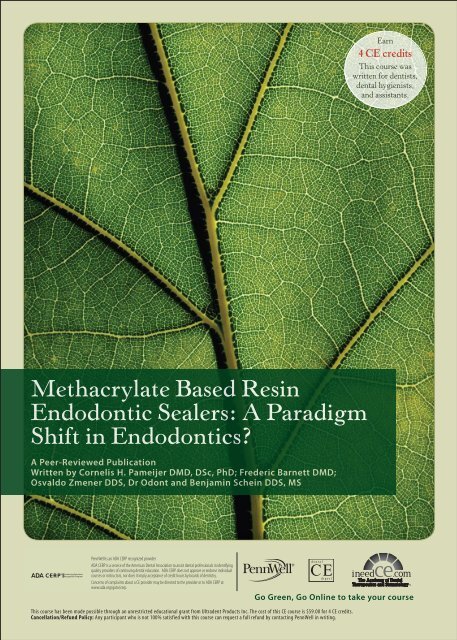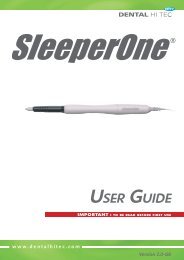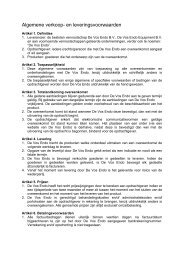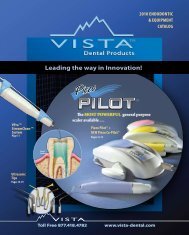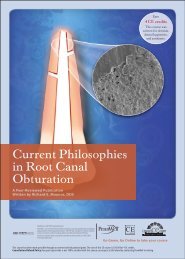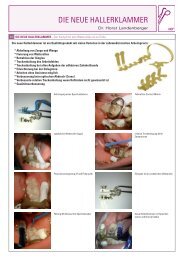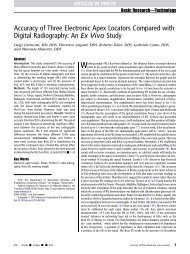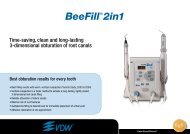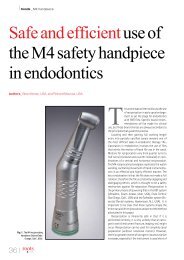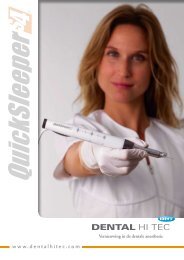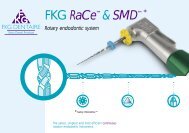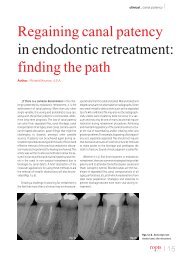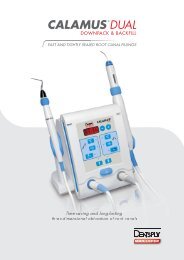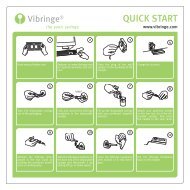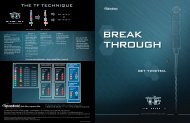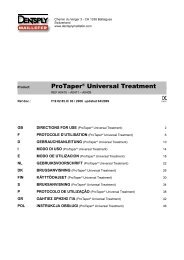Methacrylate Based Resin Endodontics Sealers ... - De Vos Endo BV
Methacrylate Based Resin Endodontics Sealers ... - De Vos Endo BV
Methacrylate Based Resin Endodontics Sealers ... - De Vos Endo BV
- No tags were found...
Create successful ePaper yourself
Turn your PDF publications into a flip-book with our unique Google optimized e-Paper software.
Earn4 CE creditsThis course waswritten for dentists,dental hygienists,and assistants.<strong>Methacrylate</strong> <strong>Based</strong> <strong>Resin</strong><strong>Endo</strong>dontic <strong>Sealers</strong>: A ParadigmShift in <strong><strong>Endo</strong>dontics</strong>?A Peer-Reviewed PublicationWritten by Cornelis H. Pameijer DMD, DSc, PhD; Frederic Barnett DMD;Osvaldo Zmener DDS, Dr Odont and Benjamin Schein DDS, MSPennWell is an ADA CERP recognized providerADA CERP is a service of the American <strong>De</strong>ntal Association to assist dental professionals in identifyingquality providers of continuing dental education. ADA CERP does not approve or endorse individualcourses or instructors, nor does it imply acceptance of credit hours by boards of dentistry.PennWell is an ADA CERP Recognized ProviderConcerns of complaints about a CE provider may be directed to the provider or to ADA CERP atwww.ada.org/goto/cerp.Go Green, Go Online to take your courseThis course has been made possible through an unrestricted educational grant from Ultradent Products Inc. The cost of this CE course is $59.00 for 4 CE credits.Cancellation/Refund Policy: Any participant who is not 100% satisfied with this course can request a full refund by contacting PennWell in writing.
Educational ObjectivesUpon completion of this course, the clinician will be ableto do the following:1. Be knowledgeable concerning the introduction ofmethacrylate based resin sealers2. Be knowledgeable about leakage studies conductedon methacrylate based resin sealers and the factorsthat influence the outcomes of these tests3. Understand the advantages that methacrylatebased resin sealers may offer over other endodonticobturation materials4. Be knowledgeable about the clinical technique usedto place methacrylate based resin sealersAbstractBonding materials and techniques have completelychanged the way dentistry is practiced. Since their introduction,techniques have evolved such that it is nowpossible to bond materials to dentin, and hydrophobicresins have been replaced by hydrophilic resins. In recentyears several methacrylate resin-based root canal sealers(MBRSs) have been introduced as an alternative toconventional gutta-percha and zinc oxide-eugenol-basedtechniques. Efforts to introduce a simplified obturationtechnique based on dentin bonding principles coupledwith favorable physical properties have contributed to anincrease in interest in using this approach. It is the intentof the authors to critically review the published literatureand to arrive at an opinion as to the current status andfuture of methacrylate based resin sealers. This will befollowed by presentations of cases in which methacrylatebased resin sealers were used.IntroductionThe acid etch bonding technique was introduced todentistry in the mid-1950s by Buonocore 1 and was basedon resin technology developed by Hagger. 2 Bondingmaterials and techniques have completely changed theway dentistry is practiced. Hydrophobic resins werereplaced by hydrophilic materials, and about 30 years ofresearch resulted in a change from using 85% phosphoricacid liquid for 60 seconds to etch enamel to using 35%phosphoric acid gels for 15 seconds for both dentin andenamel. Later, resin-based sealers and different obturationmaterials were introduced into endodontics.Before a newly developed material should be usedclinically, a series of tests needs to be performed to determineits biocompatibility. The currently used methacrylatebased resin sealers that will be discussed havebeen tested rigorously, with the exception of clinicalprospective studies. They did, however, undergo userevaluation tests. There is a legitimate concern on thepart of manufacturers that if a prospective study wereto be done — and in endodontics ideally with at least a5-year postoperative follow-up — the time elapsed frominitiation of the project until the final results are obtainedwould be excessive and counterproductive. Frequently,improvements in materials and changes in techniquesare introduced after materials are on the market andare based on clinical feedback from practitioners anddata from researchers. The ultimate success can only bedetermined when a material or technique is used successfullyin clinical practice. <strong>Based</strong> on their long track record,gutta-percha and zinc oxide-eugenol and other conventionalsealers should serve as the “gold standard” for ameaningful comparison.<strong>Methacrylate</strong> based resin sealers<strong>Methacrylate</strong> based resin sealers are based on polymerchemistry technology, initially developed for adhesiverestorative dentistry. Attention will be focused ontwo systems:1. <strong>Endo</strong>REZ (Ultradent Products Inc. SouthJordan, UT)2. Epiphany (Pentron Clinical, Wallingford,CT)/ Resilon<strong>Endo</strong>REZ is a hydrophilic, two-component, chemicalor dual-curing sealer and contains zinc oxide, barium sulfate,resins, and pigments in a matrix of urethane dimethacrylate.The sealer can be used with gutta-percha or withresin-coated gutta-percha, the latter with the objective offorming a monoblock (Figure 1).Figure 1. <strong>Endo</strong>REZEarly publications, including those of Becce andPameijer, reported on the biocompatibility and adhesivenessof <strong>Endo</strong>REZ, the latter based on its hydrophilicproperties. 3,4 Subsequently, publications appeared testingthe different MBRSs using a variety of techniques, whichto a large extent have caused more controversy than thatthey solved concerns regarding safety and efficacy, andwhether they are long-lasting and will ultimately replacegutta-percha and conventional sealers.Products such as RealSeal (Sybron <strong>De</strong>ntal Specialties,Orange, CA), SimpliFill (LightSpeed Technology Inc.,San Antonio, TX) and <strong>Resin</strong>ate (Obtura Spartan, Fenton,MO) are all categorized under Epiphany/Resilon.Resilon is composed of polymer-based resin (polycaprolactone),bioactive glass, bismuth oxide, barium sulfate,and coloring agents. Epiphany contains a dual curesealer, UDMA, PEGDMA, EBPADMA and BISGMA,barium-borosilicate, BaSO 4, bi oxychloride, calcium2 www.ineedce.com
hydroxide, photo initiators, and a thinning resin. In addition,the system comes with a self-etching primer. Thepremise behind the material is the formation of a “monoblock”(the primer forms a hybrid layer that bonds to thesealer, which in turn bonds to the Resilon core).<strong>Methacrylate</strong> based resins sealers enable obturation ina slightly moist root canal because they are hydrophilic.This hydrophilicity, combined with advanced bondingtechniques and a user-friendly methodology (<strong>Endo</strong>REZ),encourages the formation of deep resin tags extendinginto the dentinal tubules from the root canals. <strong>De</strong>epresin tags help enhance bonding and the clinical successof obturation.Figure 2. Epiphany/ResilonLeakage studiesIt is well established that selection of an appropriate sealerwill influence the outcome of endodontic therapy. 5,6 Forthat reason many investigators have focused on this importantaspect, using techniques such as fluid filtration,dye penetration, and bacterial leakage to test coronal andapical leakage of MBRS. Frequently, AH Plus or AH 26are used as control materials.In one of the first published leakage tests using Indiaink, Zmener and Banegas 7 in 2004 reported no statisticallysignificant difference between <strong>Endo</strong>REZ and AHPlus. Orucoglu et al., 8 using the fluid filtration method,reported that Diaket with cold lateral condensation leakedless apically than <strong>Endo</strong>REZ and AH Plus did. Neto etal. 9 reported that AH Plus leaked less than <strong>Endo</strong>REZ andAH 26 when using a single cone technique. Adanir et al. 10found that resin-based sealers were more effective thanzinc oxide-eugenol in sealing root canals, again using thefluid filtration method. Using similar techniques, Onayet al. 11 found that the apical seal of Epiphany and Resilonwas not different from those of AH Plus and gutta-percha,AH Plus and Resilon, or Epiphany and gutta-percha. Incontrast, Tunga and Bodrumlu 12 concluded by means of afluid-transport method that Epiphany and Resilon leakedsignificantly less (p
supported by more recent studies by Pameijer, Zmener,and Banegas.<strong>Based</strong> on testing, <strong>Endo</strong>REZ was determined to be biocompatibleand was introduced to the dental profession.The role of moistureThe data from several of the leakage studies are mostlikely the result of the ingrained belief that after a finalrinse root canals need to be dried thoroughly. Statementsin materials and methods sections of papers such as “thecanals were dried” 17,30 set the stage for a hydrophobicenvironment while a hydrophilic material is being used.For methacrylate based resin sealers, whether <strong>Endo</strong>REZor to a lesser extent Epiphany, to establish a proper sealthe dentin needs to be moist to allow for the penetrationof resin tags in the opened dentinal tubules, thus takingadvantage of the hydrophilicity of the bonding agentor sealer. In the case of <strong>Endo</strong>REZ, this allows for deeppenetration of resin tags, up to 500 µm or more, and forEpiphany allows bonding of the adhesive by means of ahybrid layer to the dentin.Zmener et al. 31 studied four scenarios of dentinwetness/dryness for apical and coronal dye leakage usingmethylene blue. In Group 1, 95% ethanol was usedfollowed by paper points to dry the canals. In Group 2,the canals were blot dried with several paper points. InGroup 3, a luer vacuum adaptor with low vacuum for 5seconds followed by one paper point for only 1–2 secondswas used. In Group 4, the root canal remained flooded,and no effort was made to remove excess distilled water.It was theorized that perhaps the hydrophilic propertiesof <strong>Endo</strong>REZ with the scenario in Group 4 would displaceexcess water. <strong>Endo</strong>REZ and Epiphany/Resilon inGroups 2 and 3 exhibited significantly less coronal andapical leakage (p
sealers cannot cause irritation. Conversion of monomerin a typical polymerization reaction is at best less than50–70%. 34 Oxygen left behind from NaOCL inhibits polymerization.Therefore, it is of importance to thoroughlyflush the root canal with EDTA after the use of NaOCL,followed by sterile saline or 2% chlorhexidine (Consepsis,Ultradent Products Inc.).Clinical evidenceOne long-term study on <strong>Endo</strong>REZ has been reported(Zmener and Pameijer 35,36 ) and one intermediate clinicalstudy on Epiphany/Resilon (<strong>De</strong>belian 37 ). In a retrospectivestudy on 180 patients, 35 a total of 295 root canalswere treated with laterally condensed gutta-percha conesin conjunction with <strong>Endo</strong>REZ. Root canal therapy wascarried out in one visit using standardized techniques.The results were assessed clinically and radiographically14 to 24 months postoperatively and compared tobaseline radiographs. Parameters for success were basedon absence of clinical symptoms, a normal or slightlywidened periodontal ligament, and reduction of periapicalradiolucencies with an absence of pain in patientswho had pre-existing lesions associated with pain. After2 years, the overall success rate was 91.03%. In a subsequent5-year follow-up, 36 129 of the patients respondedto a recall request. Root canals had been adequately filledto the working length in 92 teeth (76.66%) and short in13 (10.83%). Fifteen cases (12.50%), filled flush at theinitiation of the experiment, showed slight resorption ofthe filling material at the apex within the lumen of theroot canal. Of the 10 roots with extrusion, none had radiographicevidence of sealer in the periradicular tissuesafter 5 years. All patients were free of clinical symptoms.A life table analysis revealed a cumulative probability ofsuccess of 86.3% at the 5-year recall with a 95% confidenceinterval of 79.7%–91.0%. This percentage compareswell with what has been reported in the literature forother sealers. 38,39In a 2-year prospective study on Resilon/Epiphany reportedby <strong>De</strong>belian, 37 a total of 67 vital teeth were treatedin one visit and 53 necrotic pulps in 2 visits (n=120). After2 years, 108 cases were evaluated. Using the mean ofthe Periapical Index Scores (PAI) of three evaluators, theresults can be interpreted as follows. When the PAI 1 and2 were combined (1=healed; 2=healing), success after 24months was 91.6%. It is of interest to note that the resultsreported by Zmener and Pameijer 35 after 24 months using<strong>Endo</strong>REZ were almost the same, 91.3%. It appears thatafter 2 years the materials performed similarly in spiteof different clinical protocols and different operators. Ifwe exclude all experiments that have a flawed specimenpreparation technique, in particular the drying of dentin,then MBRSs appear to perform like conventional rootcanal sealers.Do methacrylate based resin sealersreinforce roots?A comparison of intraradicular dentin bond strengthbetween Epiphany/Resilon and gutta-percha/Kerr PulpCanal Sealer EWT, using a push-out test, demonstratedthat the mean bond strength of the Epiphany/Resilongroup was significantly higher (p
canals (Figure 3). It is important to note that if lubricantsand/or rinses containing hydrogen peroxide are used(such as Glyde, RC Prep, ProLube, etc.), that the polymerizationof <strong>Endo</strong>REZ and other methacrylate based resinsealers will be inhibited and the material may never set inthe canal. When using methacrylate based resin sealers,take care to use lubricants that contain no hydrogen peroxide.Once the canal has been dried slightly using 1–2paper points, trial fit a resin-coated gutta-percha cone (orstandard gutta-percha cone). Verify the fit radiographicallyand re-fit if necessary. Once fit has been verified,remove the cone from the canal.Remove the cap and collar from the <strong>Endo</strong>REZ syringeand replace with a mixing tip. (When using a new syringebleed a small amount from the barrels to ensure even extrusionof the materials.) Then place the collar back ontothe syringe. Once the mixing tip and collar assembly arein place, verify flow of the two components (a base andcatalyst) by injecting a small portion onto a mixing pad.Once flow has been verified, remove the plunger from aSkini syringe, and back-fill through the mixing tip directlyinto a Skini syringe (Figure 4).Inject a small amount of the resin into the Skini syringeand replace the plunger, taking care to slowly insertthe plunger to avoid trapping any air bubbles in the Skinisyringe. Attach an appropriate length NaviTip (30-gaugetip) to the Skini syringe. Verify flow from the NaviTip(Figure 5).Once flow has been verified, place the NaviTip intothe canal to be obturated. The tip of the NaviTip shouldnot approach any closer than 2–3 mm from the apicalterminus of the canal. Once the NaviTip is in place inthe canal, slowly inject <strong>Endo</strong>REZ into the canal, takingcare to keep the tip of the NaviTip buried in the materialas the canal fills. As <strong>Endo</strong>REZ is hydrophilic in nature,the material will flow into lateral canals and accessorycanals, along with penetrating deep into dentinal tubules(Figure 6).Once the canal is filled to the coronal orifice, removethe NaviTip from the canal, and place the resin-coatedgutta-percha cone into the canal (Figure 7). Passivelyplace additional cones into the canal as necessary to fillthe space (Figure 8).Recently, <strong>Endo</strong>REZ accelerator has become availablethat facilitates rapid cure of <strong>Endo</strong>REZ in the canal in 4–5minutes, as compared to 20 to 30 minutes. <strong>De</strong>livery isaccomplished by dipping either accessory gutta-perchaor resin coated gutta-percha cones into the accelerator,followed by harpooning these cones in to the as yet unpolymerized<strong>Endo</strong>REZ, thus accelerating polymerization,Furthermore, a reduced volume of <strong>Endo</strong>REZ is subjectedto less polymerization shrinkage, which will benefit theseal. This technique allows the clinician to move to definitive,restorative steps almost immediately.Figure 4. Inserting methacrylate based resin sealer intoSkini syringeFigure 5. Verifying flowFigure 6. Skini syringe in use, placing <strong>Endo</strong>REZ into the canal<strong>Endo</strong>REZ can be used with most obturation techniques,including lateral compaction, vertical compaction, warmvertical, and thermal techniques. Rather than filling the canalwith <strong>Endo</strong>REZ, however, a thin coat of sealer should beapplied to the walls of the canal first, relying on the physicalforce, pressure or heat of traditional obturation methods toaccomplish the goals of traditional obturation.According to the manufacturer’s instructions, a “passive”approach to obturating the canal results in a fill thatspans and binds the intricate architecture of dentinal tubulesand lateral canals to the resin-coated gutta-percha.6 www.ineedce.com
Figure 7. Placing the resin-coated gutta-percha cone into the canalFigure 8. Placement of accessory gutta-percha conesCase 1. Pre-operative viewCase 1. Immediate post-operative viewCase 1 images courtesy of Dr. D. Kendel Garretson.Case 2. Pre-operative viewCase 2. Immediate post-operative viewCase 3. Pre-operative viewCase 3. Immediate post-operative viewwww.ineedce.com 7
After the gutta-percha cones have been placed, use a heatelement to sear off any loose ends.Successful obturation is obtained using the abovetechnique, as demonstrated by the cases.Discussion and future expectationsThe clinical success rates that have been reported forboth <strong>Endo</strong>REZ and Epiphany/Resilon are in agreementwith success rates in previous studies using conventionalsealers and gutta-percha (Ørstavik et al. 48 ; Ausburger andPeters 49 ; Friedman et al. 50 ).In addition, <strong>Endo</strong>REZ and Epiphany are well toleratedand can be considered biocompatible. Extensive useby the dental profession has proven this to be true.Technique modifications and new techniques willcontinue to be developed, and new sealers, currentlyunder development, will appear on the market within afew years. It can be anticipated that methacrylate basedresin sealers will continue to improve their appeal to thedental profession.References1. Buonocore MG. A simple method of increasing theadhesion of acrylic filling materials to enamel surfaces. J<strong>De</strong>nt Res. 1955 <strong>De</strong>c;34(6):849–53.2. Hagger, O.3. Becce C and Pameijer CH. SEM study of a newendodontic root canal sealer. J <strong>De</strong>nt Res. AADR Issue79, Abstract #866, 2001.4, Becce C and Pameijer CH. Biocompatibility of a newendodontic sealer. J <strong>De</strong>nt Res. 81, IADR Special Issue,Abstract #2483, page B-321, 2003.5. Spangberg LSW. In vitro assessment of the toxicity ofendodontic materials. Int <strong>Endo</strong>d J. 1981;14:27–34.6. Ørstavik D, Kerekes K, Eriksen HM. Clinical performanceof three endodontic sealers. <strong>Endo</strong>d <strong>De</strong>nt Traumatol.1987;3:178–186.7. Zmener O, Banegas G. Apical leakage of endodonticsealers. <strong>Endo</strong>d Pract. 2004;7:31–23.8. Orucoglu H, Sengun A, Yilmaz N. Apical leakage of resinbased root canal sealers with a new computerized fluidfiltration meter. J <strong>Endo</strong>d. 2005 <strong>De</strong>c;31(12):886–90.9. Neto UX, de Moraes IG, Westphalen VP, Menezes R,Carneiro E, Fariniuk LF. Leakage of 4 resin-based rootcanalsealers used with a single-cone technique. Oral SurgOral Med Oral Pathol Oral Radiol <strong>Endo</strong>d. 2007 May 22.10. Adanir N, Cobankara FK, Belli S. Sealing properties ofdifferent resin-based root canal sealers. J Biomed MaterRes B Appl Biomater. 2006 Apr;77(1):1–4.11. Onay EO, Ungor M, Orucoglu H. An in vitro evaluationof the apical sealing ability of a new resin-based rootcanal obturation system. J <strong>Endo</strong>d. 2006 Oct;32(10):976–8. Epub 2006 Jul 10.12. Tunga U, Bodrumlu E. Assessment of the sealing abilityof a new root canal obturation material. J <strong>Endo</strong>d. 2006Sep;32(9):876–8.13. Stratton RK, Apicella MJ, Mines P. A fluid filtrationcomparison of gutta-percha versus Resilon, a new softresin endodontic obturation system. J <strong>Endo</strong>d. 2006Jul;32(7):642–5.14. Shipper G, Ørstavik D, Teixeira FB, Trope M. Anevaluation of microbial leakage in roots filled with athermoplastic synthetic polymer-based root canal fillingmaterial (Resilon). J <strong>Endo</strong>d. 2004 May;30(5):342–7.15. Maltezos C, Glickman GN, Ezzo P, He J. Comparison ofthe sealing of Resilon, Pro Root MTA, and Super-EBAas root-end filling materials: a bacterial leakage study. J<strong>Endo</strong>d. 2006 Apr;32(4):324–7.16. Pitout E, Oberholzer TG, Blignaut E, Molepo J. Coronalleakage of teeth root-filled with gutta-percha or Resilon rootcanal filling material. J <strong>Endo</strong>d. 2006 Sep;32(9):879–81.17. Biggs SG, Knowles KI, Ibarrola JL, Pashley DH. An invitro assessment of the sealing ability of Resilon/Epiphanyusing fluid filtration. J <strong>Endo</strong>d. 2006 Aug;32(8):759–61.18. Gernhardt CR, Kruger T, Bekes K, Schaller HG. Apicalsealing ability of 2 epoxy resin-based sealers usedwith root canal obturation techniques based on warmgutta-percha compared to cold lateral condensation.Quintessence Int. 2007 Mar;38(3):229–34.19. Sevimay S, Kalayci A. Evaluation of apical sealing abilityand adaptation to dentine of two resin-based sealers. JOral Rehabil. 2005 Feb;32(2):105–10.20. Aptekar A, Ginnan K. Comparative analysis ofmicroleakage and seal for 2 obturation materials:Resilon/Epiphany and gutta-percha. J Can <strong>De</strong>nt Assoc.2006 Apr;72(3):245.21. Huang FM, Tai KW, Chou MY, Chang YC. Cytotoxicityof resin-, zinc oxide-eugenol-, and calcium hydroxidebasedroot canal sealers on human periodontal ligamentcells and permanent V79 cells. Int <strong>Endo</strong>d J. 2002Feb;35(2):153–8.22. Huang TH, Lee H, Kao CT. Evaluation of the genotoxicityof zinc oxide eugenol-based, calcium hydroxide-based,and epoxy resin-based root canal sealers by comet assay.J <strong>Endo</strong>d. 2001 <strong>De</strong>c;27(12):744–8.23. Koulaouzidou EA, Papazisis KT, Beltes P, GeromichalosGD, Kortsaris AH. Cytotoxicity of three resin-basedroot canal sealers: an in vitro evaluation. <strong>Endo</strong>d <strong>De</strong>ntTraumatol. 1998 Aug;14(4):182–5.24. Bouillaguet S, Wataha JC, Tay FR, Brackett MG, LockwoodPE. Initial in vitro biological response to contemporaryendodontic sealers. J <strong>Endo</strong>d. 2006 Oct;32(10):989–92.Epub 2006 Jul 2625. Key JE, Rahemtulla FG, Eleazer PD. Cytotoxicity of a newroot canal filling material on human gingival fibroblasts. J<strong>Endo</strong>d. 2006 Aug;32(8):756–8.26. Eldeniz AU, Mustafa K, Ørstavik D, Dahl JE. Cytotoxicityof new resin-, calcium hydroxide- and silicone-based rootcanal sealers on fibroblasts derived from human gingivaand L929 cell lines. Int <strong>Endo</strong>d J. 2007 May;40(5):329–37.27. Hume WR, Mount GJ. In vitro studies on the potentialfor pulpal cytotoxicity of glass-ionomer cements. J <strong>De</strong>ntRes. 1988 Jun;67(6):915–8.28. Doherty PJ. Biocompatibility evaluation of glass ionomercement using cell culture techniques. Clin Mater.1991;7(4):335–40.29. Schedle A, Franz A, Rausch-Fan X, Spittler A, LucasT, Samorapoompichit P, Sperr W, Boltz-NitulescuG. Cytotoxic effects of dental composites, adhesivesubstances, compomers and cements. <strong>De</strong>nt Mater. 1998Nov;14(6):429–40.30. Kardon BP, Kuttler S, Hardigan P, Dorn SO. An in vitroevaluation of the sealing ability of a new root-canalobturationsystem. J <strong>Endo</strong>d. 2003;29(10);658–61.31. Zmener O, Alvarez Serrano S, Vidueira M, MacchiR, Pameijer CH. Coronal and apical leakage with tworesin-based sealers under different root canal moistureconditions. Submitted for publication 2007.32. Gillespie WT, Loushine RJ, Weller RN, Mazzoni A, etal. Improving the performance of <strong>Endo</strong>REZ root canal8 www.ineedce.com
sealer with a dual-cured two-step self-etch adhesive. II.Apical and coronal seal. J <strong>Endo</strong>d. 2006;32:771–5.33. Lambrechts P, Van Meerbeek B, Bergmasn L, MoisiadsisP. Unpublished data, 2006.34. Kildal KK, Ruyter IE. How different curing methodsaffect the degree of conversion of resin-based inlay/onlaymaterials. Acta Odontol Scand. 1994 Oct;52(5):315–22.35. Zmener O and Pameijer CH. Clinical and radiographicevaluation of a <strong>Resin</strong>-based root canal sealer. Am J <strong>De</strong>nt.2004;17:19–22.36. Zmener O and Pameijer CH. Clinical and radiographicalevaluation of a resin-based root canal sealer: A 5-yearfollow-up. J <strong>Endo</strong>d. 2007;33:676–9.37. <strong>De</strong>belian G. Treatment outcome of teeth treated withan evidence-based disinfection protocol and filled withResilon. J <strong>Endo</strong>d. 2006;32: Abstract #PR4.38. Swartz DB, Skidmore AE, Griffin JA. Twenty years ofendodontic success and failure. J <strong>Endo</strong>d. 1983;9:198–202.39. Ørstavik D, Kerekes K, Eriksen HM. Clinical performanceof three endodontic sealers. <strong>Endo</strong>d <strong>De</strong>nt Traumatol.1987;3:178–86.40. Skidmore LJ, Berzins DW, Bahcall JK. An in vitrocomparison of the intraradicular dentin bond strength ofResilon and gutta-percha. J <strong>Endo</strong>d. 2006 Oct;32(10):963–6.41. Teixeira FB, Teixeira EC, Thompson JY, Trope M.Fracture resistance of roots endodontically treated witha new resin filling material. J Am <strong>De</strong>nt Assoc. 2004May;135(5):646–52.42. Ungor M, Onay EO, Orucoglu H. Push-out bondstrengths: the Epiphany-Resilon endodontic obturationsystem compared with different pairings of Epiphany,Resilon, AH Plus and gutta-percha. Int <strong>Endo</strong>d J. 2006Aug;39(8):643–7.43. Grande NM, Lavorgna L, Ioppolo P, Bedini R, PameijerCH, Somma F. Influence of different root canal fillingmaterials on the mechanical properties of root canaldentin. J <strong>Endo</strong>d. 2007;33:859–64.44. Gesi A, Raffaelli O, Goracci C, Pashley DH, Tay FR, FerrariM. Interfacial strength of Resilon and gutta-percha tointraradicular dentin. J <strong>Endo</strong>d. 2005 Nov;31(11):809–13.45. Leinfelder KF. A critical analysis of recent research onResilon obturation material.46. de Oliveira DP, Barbizam JV, Trope M, Teixeira FB.Comparison between gutta-percha and Resilon removalusing two different techniques in endodontic retreatment.J <strong>Endo</strong>d. 2006 Apr;32(4):362–4.47. Ezzie E, Fleury A, Solomon E, Spears R, He J. Efficacyof retreatment techniques for a resin-based root canalobturation material. J <strong>Endo</strong>d. 2006 Apr;32(4):341–4.48. Ørstavik D, Kerekes K, Eriksen HM. Clinical performanceof three endodontic sealers. <strong>Endo</strong>d <strong>De</strong>nt Traumatol.1987;3:178–86.49. Ausburger RA, Peters DD. Radiographic evaluation ofextruded obturation materials. J <strong>Endo</strong>d 1990;16:492–7.50. Friedman S, Lost C, Zarrabian M, Trope M. Evaluationof success and failure after endodontic therapy using aglass ionomer cement sealer. J <strong>Endo</strong>d. 1995;21:384–90.Author ProfilesCornelis H. Pameijer, DMD, MScD, DSc, PhDDr. Pameijer earned his dental degreesfrom the University of Utrecht in TheNetherlands and Boston University,Boston, MA. In addition, he holds aPhD from the University of Lund inSweden, as well as an MScD, DSc,and Certificate of Advanced Graduatestudies in Prosthodontics, from Boston University. Dr.Pameijer is currently Professor Emeritus at the Universityof Connecticut, Farmington, CT. Dr. Pameijer haspublished over 200 publications in mostly peer reviewedjournals and is on the editorial board of many scientificjournals. He has lectured extensively nationally and internationallyin Europe, Asia, North and South Americaand Africa. Dr.Pameijer is currently a consultant for severalAmerican and European companies and spends histime doing research, writing publications, lecturing andone day private practice.Dr. Frederic BarnettDr. Frederic Barnett, DMD is the Chairman and Director,IB Bender Division of Postdoctoral <strong><strong>Endo</strong>dontics</strong> atthe Albert Einstein Medical Center in Philadelphia, PA.Dr. Osvaldo Zmener DDSDr. Osvaldo Zmener DDS, Dr Odont is Head Professor ofthe Post Graduate Program for Specialized <strong><strong>Endo</strong>dontics</strong>,Faculty of Medical Sciences at the School of <strong>De</strong>ntistry,University of El Salvador, Buenos Aires, Argentina.Dr. Benjamin Schein, DDS, MSDr. Benjamin Schein, DDS, MS is an endodontist in privatepractice in Las Vegas, NV.DisclaimerThe authors of this course have no commercial ties with thesponsors or the providers of the unrestricted educationalgrant for this course.Reader FeedbackWe encourage your comments on this or any PennWell course.For your convenience, an online feedback form is available atwww.ineedce.com.www.ineedce.com 9
1. The acid-etch bonding techniquewas based on resin technologydeveloped by _______.a. Haggerb. Blackc. Simonsend. none of the above2. Hydrophobic resins have been replacedby hydrophilic materials.a. Trueb. False3. When acid-etch bonding techniqueswere first used in dentistry, they used_____ for _____ to etch _____.a. 35% phosphoric acid; 60 seconds; enameland dentinb. 35% phosphoric acid; 60 seconds; enamelc. 85% phosphoric acid; 60 seconds; enameld. none of the above4. Frequently, improvements in materialsand changes in techniques are introducedafter materials are on the marketand are based on clinical feedback frompractitioners and data from researchers.a. Trueb. False5. The primer used with Epiphany _____.a. is self-etchingb. forms a hybrid layer that bonds to the sealerc. is a pure white color upon visual examinationd. a and b6. <strong>Endo</strong>REZ _____.a. is hydrophilicb. contains zinc oxidec. can be used with gutta-percha or resin-coatedgutta-perchad. all of the above7. Resilon’s composition includes _____.a. barium sulfateb. polymer-based resinc. calcium hydroxided. all of the above8. Many investigators have focused on theselection of a sealer because _____.a. this is an easy thing to studyb. manufacturers of gutta-percha havemandated thisc. selection of an appropriate sealer will influencethe outcome of endodontic therapyd. all of the above9. Techniques used to investigate sealers,and addressed in this paper, haveincluded iontophoresis.a. Trueb. False10. Using fluid filtration methods,Orucoglu et al. as well as Adanir et al.reported that <strong>Endo</strong>REZ leaked morethan zinc oxide–eugenol did.a. Trueb. False11. Huang et al. found in cytotoxicity teststhat _____ was the least toxic.a. calcium hydroxideb. calcium sulfitec. sodium perborated. none of the above12. Early toxicology studies by Louw,Becce, and Pameijer and later studies byPameijer, Zmener, and Banegas havefound <strong>Endo</strong>REZ to be mildly irritatingand within acceptable standards.a. Trueb. FalseQuestions13. The data from several of the leakagestudies discussed in this article are mostlikely the result of the ingrained beliefthat _____.a. after a final rinse, root canals must be treatedwith EDTAb. after a final rinse, root canals need to bedried thoroughlyc. before a final rinse, root canals need to be etchedd. a and c14. For methacrylate based resin sealers, toestablish a proper seal the dentin needsto be _____ to allow for the _____.a. dry; penetration of resin tags in the closeddentinal tubulesb. moist; penetration of resin tags in the closeddentinal tubulesc. moist; penetration of resin tags in the openeddentinal tubulesd. none of the above15. Leaving dentin moist prior to using<strong>Endo</strong>REZ sealer _____.a. allows for permutation of resin tagsb. enables deep penetration of resin tags up to 50 μmc. enables deep penetration of resin tags up to500 μmd. a and c16. Leaving dentin moist prior to usingEpiphany _____.a. enables deep penetration of resin tags intothe cementumb. enables bonding of the adhesive by means of ahybrid layer to the dentinc. enables bonding of the adhesive by means of ahybrid later to the cementumd. a and c17. <strong>Endo</strong>REZ and Epiphany both use adentin bonding agent.a. Trueb. False18. According to the article, the methodologyof leakage studies that state intheir materials and methods sectionsthat “the canals were dried with paperpoints” is _____ .a. appropriateb. correctc. flawedd. a and b19. Using FESEM, Lambrechts et al.showed resin tag bundles protrudingfrom the root canal filling surface andextending _____ after <strong>Endo</strong>REZ wasused as a sealer.a. from 200 to 400 μmb. from 400 to 600 μmc. from 500 to 700 μmd. none of the above20. <strong>Resin</strong> does not polymerize when incontact with air.a. Trueb. False21. It is important to thoroughly flush theroot canal with EDTA after the use ofNaOCl, followed by sterile saline or 2%chlorhexidine because_____.a. this helps EDTA form a bond with the resinb. oxygen left behind from NaOCL promotespolymerization, thus forming an oxygeninhibitedlayerc. oxygen left behind from NaOCL inhibits polymerization,thus forming an oxygen-inhibited layerd. a and b22. In a retrospective study on 180 patients,where <strong>Endo</strong>REZ was used as the rootcanal sealer, _____.a. after 2 years, the overall success rate was 91.03%b. after 5 years, all patients evaluated were free ofclinical symptomsc. a and bd. none of the above23. The ability to re-treat endodonticallytreated teeth is one of the requirementsof a root canal sealer.a. Trueb. False24. Compared to gutta-percha and AHPlus, one study found that a methacrylatebased resin sealer (Epiphany/Resilon)could be removed faster and withless residual filling material.a. Trueb. False25. Leaving a small amount of moisturein root canals after final rinsing is beneficialfor methacrylate resin–basedsealers _____.a. due to the hydrophobic nature of the sealerb. due to the hydrophilic nature of the sealerc. due to the poor porosity of dentind. none of the above26. Use of lubricants and/or rinses containinghydrogen peroxide will _______.a. promote demineralizationb. promote polymerization of methacrylate basedresin sealersc. inhibit polymerization of methacrylate basedresin sealersd. a and c27. <strong>Endo</strong>REZ will flow into lateral canalsand accessory canals because it is _____.a. hydrophobicb. hydrophilicc. thinner in viscosity than waterd. a and c28. A resin-coated gutta-percha pointshould be placed in the root canal priorto placing any methacrylate based resinsealer in the canal.a. Trueb. False29. An accelerator is available and _____.a. speeds up setting of <strong>Endo</strong>REZb. should be placed in the canal prior toplacing sealerc. should be coated on accessory gutta-percha pointsprior to placing these in the canald. a and c30. Both <strong>Endo</strong>REZ and Epiphany/Resilon _____.a. are well-tolerated and biocompatibleb. have been extensively used by thedental professionc. have been studied and found to have clinicalsuccess rates in agreement with success ratesusing conventional sealers and gutta-perchad. all of the above10 www.ineedce.com


